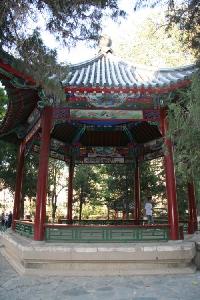Culture
Royalty Remembered in Old Tientsin
(Tianjin Today)
Updated: 2012-05-02
Last year Wellington College opened its doors in Tianjin. The partner school in the Britain was founded by Queen Victoria in 1859. HRH Prince Andrea, Duke of York is a College Visitor and was here for the College's inauguration. Once more, Tianjin has royal links. In the past, when there was a sizeable British community living in the so-called British Concession stretching from today's Ying Kou Dao to Tong Lou, allegiance to the various British monarchs was evident in the names given to several public places.
In the mid 1890s, Gustav Detring, an influential member of the 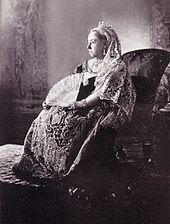 British Municipal Council which presided over the British Concession, and Byron Brenan, then British Consul, proposed the building of a grand park to be named after Queen Victoria as a fitting acknowledgement of her sixty year reign. The land allocated had previously been 'a noisome swamp' lying next to the Astor House Hotel (now the Astor Hotel or Li Shun De). Victoria Park was officially opened on 21 June 1887 with festivities including athletic sports, firework display and official addresses. For several years an interesting menagerie occupied one corner of the park. There was a bandstand which remains today. Assorted army bands played to smartly dressed people sitting on green benches nearby or strolling along the paths between the flower beds 1. A description of the park appears in the Peking and Tientsin Times of May 1896:
British Municipal Council which presided over the British Concession, and Byron Brenan, then British Consul, proposed the building of a grand park to be named after Queen Victoria as a fitting acknowledgement of her sixty year reign. The land allocated had previously been 'a noisome swamp' lying next to the Astor House Hotel (now the Astor Hotel or Li Shun De). Victoria Park was officially opened on 21 June 1887 with festivities including athletic sports, firework display and official addresses. For several years an interesting menagerie occupied one corner of the park. There was a bandstand which remains today. Assorted army bands played to smartly dressed people sitting on green benches nearby or strolling along the paths between the flower beds 1. A description of the park appears in the Peking and Tientsin Times of May 1896:
"Victoria Park has awoken from its sleep and desolation, the foliage is in all its vernal glory, the coo of the dove and the voice of the turtle blend with the scream of the cock-a-too and the call of the Amah [Ayi]; the Band actually plays three times a week… the pristine glories of the garden are restored".
Later the paper has comments showing it was not always so pristine!
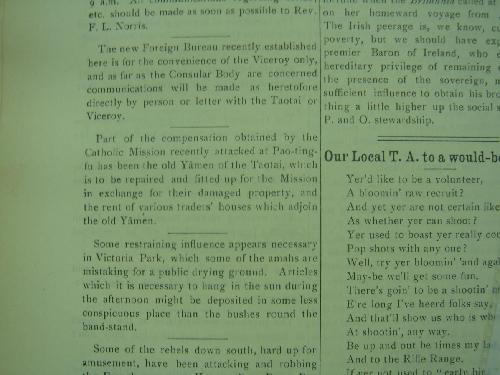 |
| From: Peking and Tientsin Times, September 3, 1898 p.108 |
For a time, there were lawn tennis courts though these were removed to the Recreation Grounds (now Xinhualu Stadium) amidst some controversy1. Consistent with the exclusivist policy of the day, no dogs or Chinese were allowed in the park. Chinese ayis in charge of children and prominent Chinese were an exception. Bicycles and balls were forbidden.
During the YiHeTuan movement or Boxer rebellion of 1900, a Chinese firebell located by Governor Li Hingzhang's office, was taken by foreign troops and placed in the park2 . Another account suggests the bell had been in a pagoda called the Light of the Sea pagoda after a lighthouse which had been there when Tianjin was on the coast. All that remained was a large bronze bell used to warn people in the event of a fire, flooding or attack from warlords.
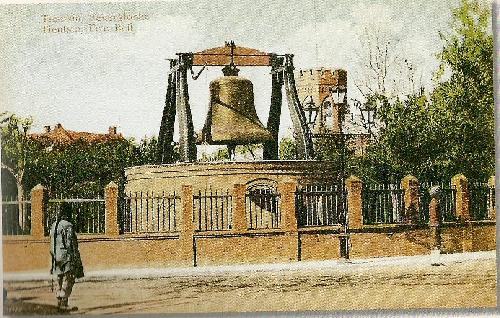 |
|
From : Leyden, M. (2002) China-Tianjin Postal and Cultural History. p.77 |
After the First World War, the bell was removed to make way for a cenotaph, replicating that in Whitehall, as a memorial to those who had perished in the war. Wreaths were laid annually. Some local Chinese apparently believed that the spirits of those who once worshipped there still haunted the site and were angered by the bell's removal. The park became a focal point for a number of national celebrations.
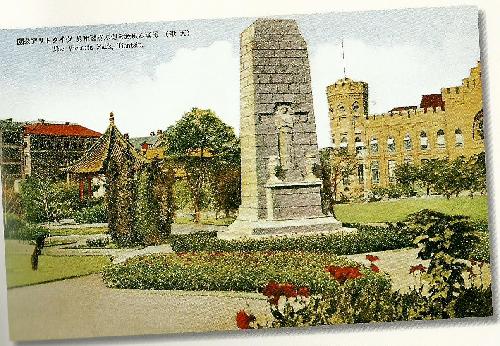 |
|
From : Leyden, M. (2002) China-Tianjin Postal and Cultural History. p.71 |
A further commemoration was the establishment of the Queen Victoria Diamond Jubilee Memorial Hospital and Nursing Home, known as the Victoria Hospital (exact location not verified). This project was initiated by Dr H.R.Robertson with the generous support of Mr J.M. Dickinson who invited others to subscribe (such as the British
|
|
|
The bandstand in the park opposite the Astor, October 2010 (copyright A Klopper) |
Legation in Peking). The British Municipal Council provided the site charging only the customary ground rent. The design and plans were drawn up pro deo by A.W. Harvey Bellingham. Until this time, the only hospital available was the General Hospital in the French Concession where some French Roman catholic nuns served devotedly. The new hospital would provide for ordinary medical and surgical needs and was intended for all nationalities. The foundation laying ceremony was a grand affair: the Free Masons were there in full Masonic regalia, there was a blue-jacketed contingent from HMS Peacock, the British Consul Mr B.C.G. Scott was in full civil service uniform. The stone was laid by Mrs Lees, the longest lady resident of Tientsin, who commented that the hospital would help "do something to lessen the sum of human suffering". Beneath the stone was placed a securely-sealed zinc box containing copies of the Peking and Tientsin Times, lists of subscribers and the inscription, a photo of Mrs Lees, various currencies of the day1. Subsequently there were almost annual alterations and additions. By April 1930, there were a total of eleven beds and some 40 000 people were served but the hospital was coming under increasing criticism for its draughty wards, limited bathrooms, old-fashioned washstands and lack of piped water, inconvenient layout, antiquated and sub-standard equipment2 although staff were praised as "extremely efficient, hard-working, pleasant and sympathetic".
The esteem in which Queen Victoria was held was also seen in the naming of the main road cutting through the British Concession known as Victoria Road (now Nanjing Lu). Behind the Tientsin Club (now Municipal Party committee building), there was a development known as the Victoria Terrace. It consisted of twenty 4-roomed houses with downstairs dining room, drawing room and verandah with two bedrooms and a bathroom upstairs. There was also a small Western-style restaurant called the Victoria Café (now Kieslings Restaurant in Xiao Bai Lou) started by Mr Bresler.
In 1935, King George V's silver jubilee was commemorated with the
 |
|
Corner entrance to the park October 2010, now remodelled again. (copyright A Klopper) |
